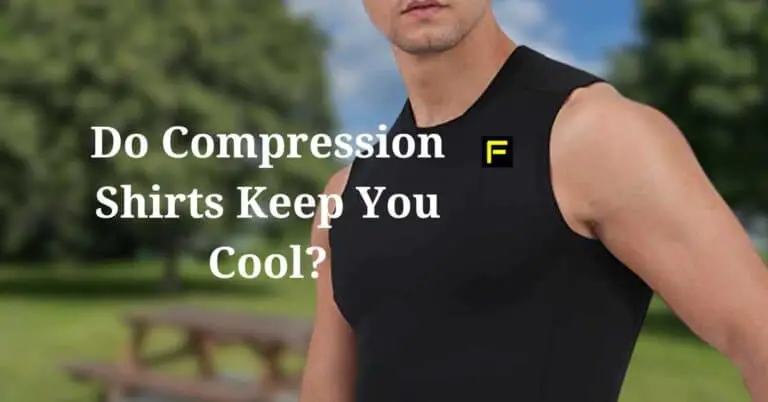Discover the go-to baselayer of athletes when temperatures rise

Do Compression Shirts Keep You Cool during intense workouts or summer runs?
** I may earn a commission when you purchase through a link on this page. **
This question is on the minds of many athletes and fitness enthusiasts.
They are more than just a trend in athletic wear.
Compression shirts for hot weather are designed with advanced cooling technology to help manage body temperature.
Made from moisture-wicking fabric, these shirts pull sweat away from your skin.
This process is key for keeping you dry and comfortable.
But how effective are they really in temperature control and heat management?
These shirts are not just about squeezing your muscles.
They’re engineered for thermal regulation and breathability.
Imagine running outdoors in the summer heat.
Your body is heating up, but your compression shirt is working to disperse that heat.
It’s like having a personal cooling system, wrapped in a skin-tight fit.
Not only do they aim to keep you cool, but some also offer UV protection.
This is crucial for outdoor activities like running or cycling.
Compression shirts have evolved into high-performance gear.
They’re not just for gym wear but for any athletic performance where heat could be an issue.
So, let’s dive into the science and user experiences.
We’ll explore if these shirts are the ultimate solution for workout comfort and body cooling.
Stay tuned to find out how compression shirts could change the way you exercise.
What is the Best Warm-Weather Baselayer for Athletes?
When summer rolls around, athletes face the challenge of maintaining optimal body temperature during intense exercise.
One way to keep your cool is by choosing the right baselayer — a garment worn against the skin manage sweat and help regulate body temperature.
Many athletes swear by compression shirts as their warm-weather base layer of choice. But what makes them so special?
How do they manage to keep you cool when the mercury is rising?
Let’s discuss how they work, their benefits, and how to choose the best one for your needs.
Compression Shirts vs. Traditional Athletic Wear
When it comes to staying cool during workouts, compression shirts and traditional athletic wear have different approaches.
Pros and Cons of Compression Shirts
- Use advanced cooling technology.
- Made with moisture-wicking fabric that pulls sweat away from the body.
- Help in temperature control and reduces body heat.
- Tight fit supports muscles and improves athletic performance.
- Great for summer workouts because of their breathability and sweat management.
- However, their skin-tight fit might not be comfortable for everyone.
Pros and Cons of Traditional Athletic Wear
- Have a loose fit
- Doesn’t hug the body like compression gear.
- More comfortable for some people, especially in hot weather.
- Regular sports clothing doesn’t always have the same level of moisture-wicking or temperature regulation.
- Often more versatile and less expensive than compression wear.
- Does offer the same level of muscle support.
- Usually more adaptable to different types of activities.
In summary, compression shirts are excellent for intense workouts and temperature regulation.
They offer muscle support and are made with high-tech materials.
Traditional athletic wear is more about comfort and versatility.
It’s suitable for a variety of activities and often more affordable.
Choosing between the two depends on your workout style and comfort preference.
Do Compression Shirts Keep You Cool?
You might find it puzzling that tight-fitting compression clothing keeps you cool during a rigorous workout.
When examining these factors in detail, science illustrates how compression garments help regulate body temperature and keep you cool during your workouts.
You may wonder, wouldn’t more layers just make you hotter?
The reality is compression gear, including shirts and tights, functions in a unique way to maintain body temperature.
Athletic compression shirts are made using moisture-wicking materials that help to pull sweat away from your body. This evaporation process cools the skin and helps to reduce overall body heat.
The pressure exerted by compression gear on your muscles boost circulation, and this increased blood flow helps your body remove heat more effectively.
The snug fit of compression clothing minimizes the amount of fabric that trap heat against your body. This is in contrast with the effect of loose, billowy clothing.
High-quality compression wear is designed to promote airflow to your skin, aiding in cooling you down.
How to Select The Right Compression Shirts for Hot Weather
Choosing the right compression shirt for hot weather training significantly boosts your performance and comfort.
But not all compression shirts are created equal. It’s important to understand the difference between shirts designed for cold weather and those intended for hot weather.
Cold-weather compression shirts typically feature a thicker material to provide insulation, keeping your body warm during colder months.
They often use thermal properties and have a fleecy lining. These types of compression shirts are ideal for outdoor winter sports or cold-weather runs.
On the other hand, compression shirts for warm climates are quite different.
They’re made with lighter, breathable fabrics that promote ventilation and have excellent sweat-wicking abilities.
These shirts pull moisture away from the skin, encouraging quick evaporation, which helps to cool you down.
Some may also have special cooling technologies or features like mesh panels for enhanced airflow.
Tips for selecting a compression shirt to stay cool
✅ Material
Opt for light, breathable fabrics with moisture-wicking properties. Synthetic blends like polyester or nylon are good options.
✅ Sweat-wicking
Check for sweat-wicking technology. This helps to keep you dry and cool during your workouts.
✅ Fit
The shirt should fit snugly but comfortably. It should feel like a second skin without restricting your movements.
✅ Design
Look for features that promote cooling, such as ventilation zones or mesh panels.
✅ Quality
Consider the durability of the shirt. Read reviews and opt for trusted sports or athletic wear brands.
How to Wear Compression as a Baselayer to Stay Cool
As temperatures rise, how do you wear compression shirts to maximize their cooling benefits?
Do you wear it directly against your skin, or should it be paired with other clothing layers?
These are valid questions that often arise when discussing how to use compression garments as a baselayer to maintain body temperature.
If you’ve been wondering about this, you’re not alone. The idea of wearing skin-tight gear might seem counter-intuitive, especially when temperatures are already high.
But as we’ve established, compression clothing has unique characteristics helps keep you cool.
It’s important to remember that compression gear is designed to be worn as a base layer. That means it should be in direct contact with your skin.
This allows the material to wick away sweat and facilitate evaporative cooling efficiently.
When pairing compression gear with other clothing, you need to consider breathable and lightweight outer layers.
This combination ensures that the heat produced by your body and the sweat evaporated by your compression wear aren’t trapped and escape freely.
So should you wear compression gear under your regular workout clothes or not? It depends on your comfort and the specific activity.
For activities such as running or cycling, where loose clothing could hinder your motion, it’s best to wear just compression gear.
Pairing compression gear with loose-fitting clothes work for walking, stretching, or yoga.
The key is to listen to your body. If you feel cool and comfortable, you’re probably wearing it right.
With a little trial and error, you’ll find the most effective way to wear compression clothing for your body and workouts.
Purchasing Compression Gear for Warm Weather
When you’re out to buy compression shirts for warm weather, you’re after functionality, but comfort and style are essential, too.
Most types of compression gear will serve you well under the scorching sun.
They offer the essentials like breathability, sweat-wicking, and muscle support.
But what if the weather turns up a notch, sending temperatures soaring?
Or perhaps you fancy going for a jog wearing just your compression tights, without layers on top.
That’s when you need to seek out compression gear designed specifically for hot conditions.
To find these warm-weather wonders, there are several signs to look for.
Look for lighter-weight fabric to maximize breathability. Sweat-wicking is an absolute must!
Search for terms like ‘cooling technology,’ ‘ventilation zones,’ or ‘dry fit’ which indicate the garment has been designed with warm weather in mind.
The right gear makes all the difference when you need to train in conditions less than ideal.
Conclusion
Compression shirts are a game-changer for athletes and fitness enthusiasts, especially during warm weather.
These shirts are designed with advanced cooling technology, utilizing moisture-wicking fabrics to effectively manage body temperature.
By pulling sweat away from the skin, they facilitate evaporative cooling, keeping you dry and comfortable. The snug fit of compression wear not only supports muscles but also aids in heat dispersion, enhancing overall thermal comfort.
When selecting a compression shirt for hot weather, it’s important to choose light, breathable materials with sweat-wicking properties and a design that promotes airflow.
Wearing compression gear as a base layer directly against the skin maximizes its cooling benefits.
For those engaging in summer workouts or outdoor running, compression shirts offer a unique combination of temperature regulation, sweat management, and body cooling, making them an essential part of fitness apparel. T
Their ability to maintain coolness while providing UV protection and muscle support underscores their role as high-performance gear in any athletic wardrobe.

Rick Huey is a fitness writer who has dedicated his life to living an active lifestyle. With more than 30 years of experience in the fitness industry, Rick is a respected contributor for FitFab50.com, where he shares his wealth of knowledge with a wide audience. His dedication to promoting the benefits of living an active lifestyle has inspired many people to pursue their own fitness journeys with enthusiasm and dedication.










